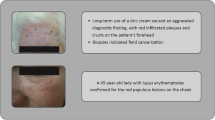Summary
Skin cancer is the most common human carcinoma. There has been a dramatic increase of the incidence over the last decades. This trend is very likely caused by the increased UV-light exposition of the population. Whereas basalioma and spinalioma as the most frequent types of skin cancer have a low mortality, the bad prognosis of malignant melanoma is the reason for the 100% increase of the mortality rate over the last ten years. Cancer prophylaxis means the early detection of precancerous or suspect lesions. Popular information on the risk and a more generous indication for excision are the best instruments to lower the mortality of skin cancer.
Zusammenfassung
Der Hautkrebs zählt zu den häufigsten Malignomen des Menschen. Er zeigt eine dramatische Zunahme der Incidenz in den letzten Jahrzehnten. Hierfür wird die vermehrte UV-Lichtexposition der Bevölkerung verantwortlich gemacht. Während die häufigsten Krebsformen Basaliom und Spinaliom nur selten zum Tode führen, bedingt die ungünstige Prognose des Melanoms eine Verdoppelung der Sterblichkeit an Hautkrebs innerhalb von 10 Jahren. Krebsvorsorge bedeutet die Erfassung von Frühstadien, d. h. präcanceröser Läsionen sowie suspekter Befunde. Nur durch konsequente Aufklärung und großzügige Indikation zur Excision läßt sich langfristig die Sterblichkeit an Hautkrebs senken.
Similar content being viewed by others
Literatur
Adam YG, Efron G (1983) Cutaneous malignant melanoma. Current views on pathogenesis, diagnosis and surgical management. Surgery 93:481–493
Altmeyer P, Nödl F, Merkel H (1980) Lymphogene Metastasierungsbereitschaft des malignen Melanoms. Dtsch Med Wochenschr 105:1769–1771
Balch CM, Soong SJ, Murad TM, Ingalls AL (1979) A multifactorial analysis of melanoma. Prognostic factors. Surgery 86:343–351
Balch CM, Soong SJ, Milton GW, Shaw HM (1983) Changing trends in cutaneous melanoma over a quarter century in Alabama, USA and New South Wales, Australia. Cancer 52:1748–1753
Balch CM, Karakousis C, Mettlin C, Natajan N (1984) Management of cutaneous melanoma in the United States. Surgery 158:311–318
Balda BR (1981) Epidemiologie kutaner Melanome. Münch Med Wochenschr 123:1923–1926
de Blois GG, Patterson JW, Hunter SB (1984) Extramammary paget disease. Arch Pathol Lab Med 108:713–716
Braun-Falco O, Schmoeckel C (1981) Maligne Melanome. Klin. Formen und Differentialdiagnose. Münch Med Wochenschr 123:1922–1927
Breslow A (1977) Problems in measurement of tumor thickness and level of invasion in cutaneous melanoma. Hum Pathol 8:l-2
Day CL, Sober AJ, Kopf AW, Lew RA (1981) A prognostic model in clin. stage I melanoma. Surgery 89:599–603
Gall FP, Tonak J (1981) Die chirurgische Therapie des alignen Melanoms, S. 103–113. In: Das maligne Melanom der Haut. Perimed, Erlangen
Hermanek P (1974) Klin. Pathologie der Haut- und Weichteiltumoren. Chirurg 45:293–308
Holman J, Amstrong K (1984) Cutaneous malignant melanoma and indicators of total accumulated exposure to sun. J Natl Cancer Inst 73:75–82
Illig L, Paul E (1982) Verbesserte Früherkennung maligner Melanome. Hautkr 57:477
Kopf AW, Kripke ML, Sten RS (1984) Sun and malignant melanoma. J Am Acad Dermatol 11:674–684
v. d. Leun JC (1984) UV-Cancerogenesis. Photochemistry and Photobiology 39:861–867
Luckasen JR (1983) Paget's disease of the breast and extramammary locatio. Clin Dermatol 4 unit 22:1–5
Robinson J, Roenigk H (1984) Basalzellkarzinom und Plattenepithelkarzinom. Hauttumoren. Klin J 5:19–28
Sober AJ (1983) Diagnosis and management of skin cancer. Cancer 15:2448–2452
Statistisches Jahrbuch (1983)
Stern RS, Momtaz K (1984) Skin typing for assessment of skin cancer risk and acute response to UV-B. Arch Dermatol 120:869–873
StevensRG, Moolgavkar SH (1984) Malignant melanoma. Am J Epidemiol 119:890–895
Swerdlow AJ, English J, Mac Kie RM (1984) Benign naevi associated with high risk of melanoma. Lancet I, 21:168
Voigt H, Kleeberg UR (1983) Herausforderung Melanom. HÄB 2/83:41–48
Weidner F (1980) Malignes Melanom der Haut. Früherkennung und Differentialdiagnose. Fortschr Med 98:1449–1451
Author information
Authors and Affiliations
Rights and permissions
About this article
Cite this article
Schumpelick, V., Grabbe, F. & Mensing, H. 96. Krebsvorsorge am Hautorgan. Langenbecks Arch Chiv 366, 501–510 (1985). https://doi.org/10.1007/BF01836695
Issue Date:
DOI: https://doi.org/10.1007/BF01836695




